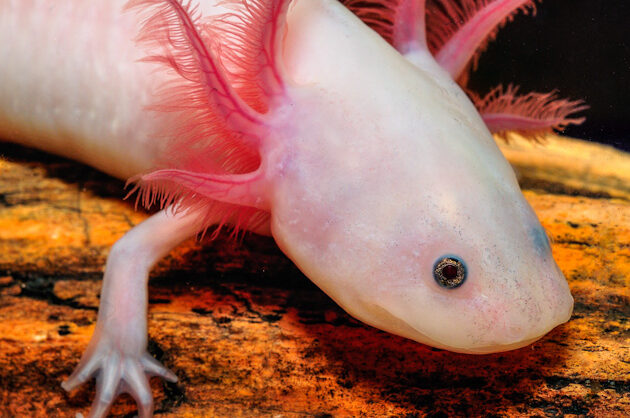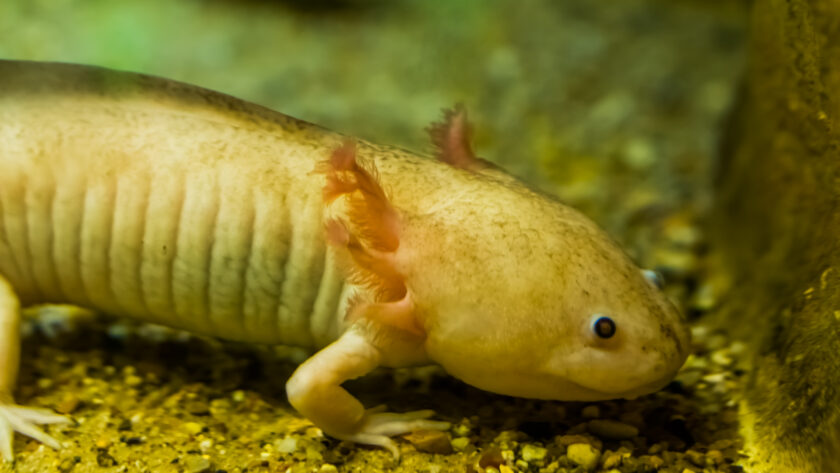Are axolotls lizards? It’s a question that has perplexed scientists and curious minds alike for centuries. But don’t worry, we’re here to unravel the mystery!
The axolotl is an unmistakable creature – it looks like no other amphibian on earth. With its strange appearance, it’s no wonder why people have been asking this question for so long.
So let’s dive in and explore what makes this mysterious amphibian so unique. You’ll gain insight into their anatomy, behavior, reproduction, evolutionary history, classification and conservation efforts.
Get ready for an incredible journey as we unearth the answer to one of nature’s great mysteries: are axolotls lizards?
Table of Contents
Overview of the Axolotl

You may have heard of the fascinating creature, but what exactly is an axolotl and how does it differ from other creatures? Let’s take a look!
The axolotl, also known as the Mexican salamander or Mexican walking fish, is an amphibian hybridization species native to Mexico. It’s easily recognizable by its feathery gills and golden eyes that can mesmerize anyone who sees it.
The unique feature of this creature is its ability to reach adulthood without undergoing metamorphosis, meaning it retains its juvenile form throughout life. This makes them particularly interesting because they’re able to adapt to different climates and environments without changing their shape or size.
They’re also highly resistant to disease due to their ability to regenerate lost body parts like tails or limbs. This combination of traits has made them incredibly popular among scientists looking into amphibian hybridization and climate adaptability.
Axolotl Anatomy
Your curiosity is like a ball of yarn, and Axolotl Anatomy is the thread that’s unraveling it. Let’s start with some basics:
Axolotls are amphibians, not lizards, and they have a unique body shape that sets them apart from other species. This includes their wide heads, long tails, and four feathery gills on either side of their heads.
As far as dietary habits go, axolotls are carnivorous and typically feed on worms or insects in the wild. They prefer to live in an aquatic environment with slow-moving water such as lakes or ponds but can also survive in habitats with fast-flowing rivers.
Axolotls also possess special features that make them stand out from other species. One example is their ability to regenerate lost limbs! That’s right – if an axolotl loses a limb, it will grow back within weeks!
But perhaps most impressive of all is their incredible skin coloration: axolotls come in various shades ranging from yellow to brown to white – even pink! And while this may seem like nothing more than a cosmetic feature, it actually serves an important purpose: camouflage! The bright colors help them blend into their environment and protect them from predators.
Axolotl Behavior
The behavior of axolotls is a fascinating subject, offering insight into the mysterious lives of these amphibians.
Axolotls are social creatures and can be seen interacting with one another in their natural habitat. They have been observed engaging in courtship behaviors such as swimming around each other and displaying their gills to one another. In addition, they have also been known to form small groups or “schools” when searching for food.
Axolotls are carnivorous animals that feed on worms, insects, and small fish. They will often hunt for food during the night time hours when it is dark and they can remain hidden from predators. They have also been known to scavenge for food if necessary, which means they’ll eat whatever is available to them at the time.
This behavior helps them survive in their environment by ensuring that they always have access to a steady supply of food sources.
Are Axolotls Lizards: Reproduction
Unlock the secrets of axolotl reproduction as you explore their unique mating rituals and reproductive cycle.
Axolotls possess a variety of breeding strategies, from broadcast spawning to courtship rituals, depending on the species. Mating behavior can range from elaborate displays of aggression to gentle affection.
During breeding season, males display aggressive behaviors like fin-biting in order to establish dominance and attract a mate. On the other hand, some species practice courtship rituals which involve elaborate movements such as circling each other or embracing with intertwined tails.
Once a pair finds each other, they will release sperm and eggs into the water together during an act known as external fertilization – meaning that neither parent provides any parental care for the offspring after they are born.
After successful fertilization, larvae will hatch about two weeks later and develop into juveniles before reaching adulthood at around one year old. Axolotls typically breed once or twice per year when temperatures reach between 12°C (53°F) and 18°C (64°F).
Through careful observation of their fascinating mating behavior and reproductive cycle, we gain greater insight into these mysterious creatures!
Evolutionary History
Uncover the evolutionary history of axolotls and explore how they’ve adapted to their environment over time.
Salamanders and lizards are distant relatives, but scientists believe that axolotls evolved from salamanders after hybridization with lizards millions of years ago.
Fossil evidence suggests that the species has been around for at least 9 million years, making them one of the oldest living vertebrates on Earth, and they’ve changed little since then.
Axolotls can be found in several different environments, including freshwater lakes and rivers in Mexico City and its surrounding areas.
This adaptation to a wide variety of habitats is what makes them so unique and resilient as a species.
Axolotls have also evolved special features like their gills that allow them to breathe underwater, as well as specialized fleshy tentacles which help them hunt prey such as fish or worms.
Their eyes are located at the top of their heads, giving them an almost 360-degree view of their surroundings – ideal for spotting potential predators or prey.
The combination of these traits make axolotls perfectly suited to life in the water, enabling them to survive even in harsh conditions where other animals would fail.
As a result, this species has endured despite massive changes in its habitat over millions of years – a testament to their remarkable adaptability!
Classification
Classifying axolotls as one of the oldest living vertebrates, it’s clear that this species has adapted to its environment over millions of years, displaying remarkable resilience and unique adaptations like specialized gills and tentacles.
From a habitat classification standpoint, axolotls are amphibians which have adapted to life in both water and land – but prefer the former.
Genetic classification is even more complex: although they are closely related to salamanders, their DNA is distinct due to their specific adaptation process over time.
Thanks to recent advancements in genetic sequencing technology, we now understand that axolotls belong to a clade called Urodela.
Within that larger category exists two distinct subgroups: Cryptobranchidae (which contain Japanese giant salamanders) and Salamandridae (the true salamanders).
Axolotls fall into the latter group with greater accuracy than any other amphibian species currently known to science!
Unraveling this mystery has been an incredible journey that continues today – making it clear just how fascinating these creatures truly are.
Conservation Efforts
You’re probably wondering what can be done to protect these amazing creatures, right? Conservation efforts have been ongoing for years to ensure the axolotl’s long-term survival.
One of the biggest threats to their existence is habitat destruction due to human activities such as farming, fishing, and pollution. To help counter this issue, scientists have created captive breeding programs in which they raise axolotls in a controlled environment and release them into suitable habitats when they reach adulthood. This helps maintain healthy populations of wild axolotls and keep their numbers from dropping significantly.
Additionally, conservation organizations are working hard to protect their natural habitats by creating protected areas and enforcing laws against environmental degradation. In addition to protecting existing populations of wild axolotls, researchers are also investigating ways to restore their former range through reintroduction projects.
These projects involve finding suitable environments where axolotls can thrive and then introducing captive-bred individuals into the area in order to create new self-sustaining populations. Although this takes a lot of time and resources, it has proven successful in many areas around the world and is an important part of ensuring the long-term survival of the species as a whole.
Frequently Asked Questions
What is the average lifespan of an axolotl?
You might be wondering how long an axolotl can live! On average, these awesome creatures have a lifespan of between 8 and 12 years when they’re given the right habitat requirements and temperature preferences.
They need to stay in cool or cold water with temperatures ranging from 10 – 20°C (50 – 68°F). If you give them a good home, they’ll reward you with many years of happy companionship!
Are axolotls found in the wild?
You won’t believe the amazing truth about wild axolotls! Despite their unique anatomy and characteristics, these special creatures are rarely encountered in their natural habitat due to drastic habitat loss.
You won’t find them just anywhere, but those lucky enough to stumble upon an axolotl in its native environment can witness a truly breathtaking experience that will stay with them forever.
So don’t miss your chance – if you ever come across an axolotl in the wild, take it as a sign of good luck!
What types of food do axolotls eat?
You may be wondering what types of food an axolotl needs. Well, the good news is that they’re not fussy eaters!
Axolotls need a diet high in protein and low in fat. So, an ideal setup for feeding them would be to feed them live or frozen foods such as bloodworms, earthworms, brine shrimp, and blackworms.
When setting up their tank, it’s best to give your axolotl plenty of hiding spots so they can feel safe while they’re eating.
With the right setup and nutrition plan, you can ensure your pet has a long and healthy life!
Are axolotls endangered?
Axolotls, an aquatic salamander native to Mexico, are unfortunately endangered due to the loss of their habitat and water pollution.
Conservation efforts have been taken to protect them with captive breeding programs and by limiting fishing activity in certain areas.
It’s important that we continue these efforts if we want to save this species from extinction.
Everyone can do their part by spreading awareness of the issue and advocating for conservation measures that protect axolotls.
How much space does an axolotl need in captivity?
Do you ever wonder how much space an axolotl needs in captivity?
You may be surprised to learn that these amazing creatures require a tank size of at least 20 gallons, although larger tanks provide them with more room for swimming and exploring.
It’s important to also consider the water quality when housing an axolotl, as they need clean and filtered water in order to thrive.
With the right tank size and water conditions, you can create a comfortable environment for your pet axolotl!
Conclusion
You’ve unraveled the mystery of whether axolotls are lizards or not. You now know that they’re a unique species of salamander, with an evolutionary history and anatomy all their own.
You can imagine their bright yellow-gold eyes watching you intently as they swim gracefully in their tanks – a perfect balance between curiosity and caution.
And you can feel proud knowing that conservation efforts are being made to ensure the longevity of this amazing species.
The axolotl is truly one of nature’s most remarkable creatures, and now you understand why!




